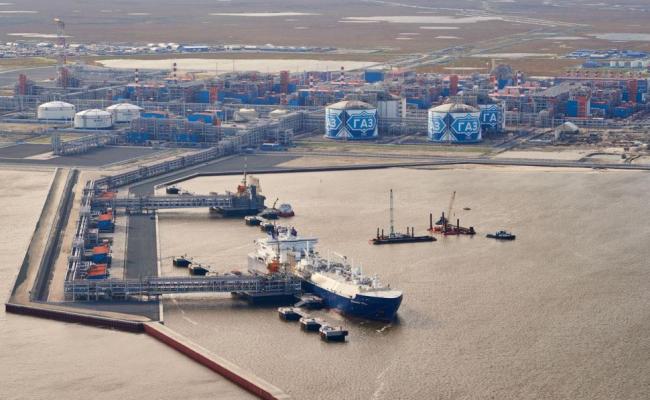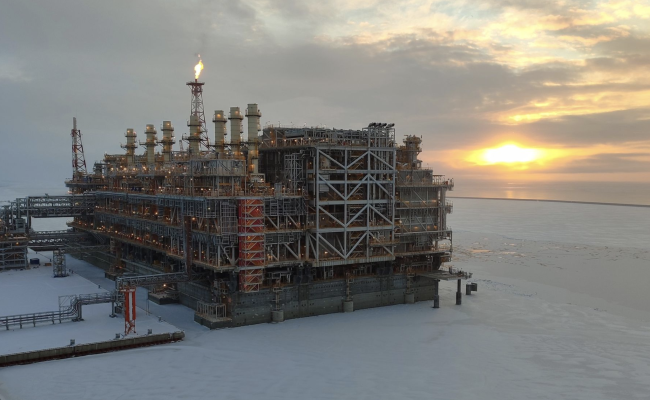EU Imports of Russian LNG Decrease by One-Third During Month of April

Arc7 LNG carriers loading LNG at Sabetta in the Russian Arctic. (Source: Novatek)
For the first time since the full-scale invasion of Ukraine EU imports of Russian liquefied natural gas have recorded a significant drop. Figures for April indicate a 35 percent reduction in deliveries in comparison to the same period last year. But it remains unclear if the reduction is just a temporary decline or the beginnings of a shift away from supercooled gas from Russia.
After trending upwards for much of the past two years and setting a new record in 2024, imports of Russian liquefied natural gas (LNG) into the EU – primarily from the Yamal project in the Arctic – saw a stark decrease for the month of April.
Data compiled by the Institute for Energy Economics and Financial Analysis (IEEFA) show a 35 percent year-over-year decrease in Russian LNG imports into the EU for the period from April 1st to 23rd.
Volumes decreased from 1.76 billion cubic meters (bcm) during that period in 2024 to 1.14 bcm this year.
Spain and to a smaller degree France account for the cutback.
“Spain has reduced imports of Russian LNG quite a bit,” confirms Ana Maria Jaller-Makarewicz at IEEFA, who compiled the data.
Russian LNG Exports during April 1st to 23rd 2024 and 2025. (Source: IEEFA)
Deliveries to Spain dropped from around 0.6 bcm to just 0.1 bcm, with France recording a decline from France at 0.7 bcm compared to 0.6 bcm. Imports are slightly up for Belgium from around 0.25 bcm to 0.3 bcm.
The news comes a month into the EU transshipment ban on Russian LNG, which does directly affect deliveries into the continent but may contribute to a shift in export patterns.
The decline in EU imports does not necessarily suggest an ongoing departure of European buyers from Russian LNG, but is likely the result of multiple factors coalescing.
Temporary shutdown
Russia’s largest operating LNG plant, Yamal LNG, experienced an unexpected shutdown earlier this month. One of its three main production lines was inoperative for a period of time in April, though based on satellite images it appears to now be back in service.
“Ten-day moving averages indicate a clear decline in LNG exports from Yamal, though it remains unclear which train is affected,” said Ana Subasic, gas and LNG Analyst at Kpler, a data and analytics firm for commodity markets.
This trend reinforces Europe’s ability to attract incremental volumes from the US
Sources tell HNN that the third train (T3) was the production line in question. The temporary shutdown resulted in fewer loadings and sailings to Europe.
EU countries have also been buying record-levels of U.S. LNG replacing some Russian volumes. Energy imports from the U.S. have come to the forefront as a means to cooperate with the Trump Administration.
During the first three months of 2025 EU member states picked up 80 percent of U.S. LNG exports.
“This trend reinforces Europe’s ability to attract incremental volumes from the US. European buyers are expected to lean heavily on LNG this summer,” continued Subasic.
Weak demand in China for super-cooled gas has also been a boon for Europe as it is looking to replenish reserves following winter months.
It remains unclear if the decline in imports from Russia is of a temporary nature or the beginning of a trend. The European Commission appears set to announce plans next month to ultimately end all imports of LNG from the country.
The measure is not expected to take effect before 2027 at the earliest.
Prior to a full ban on Russian fuels, the EU is discussing further incremental action by disallowing spot sales of Russian LNG.
This would leave in place long-term off-take agreements, e.g. with France’s TotalEnergies and Germany’s Securing Energy for Europe (SEFE), but would phase out ad hoc sales.



